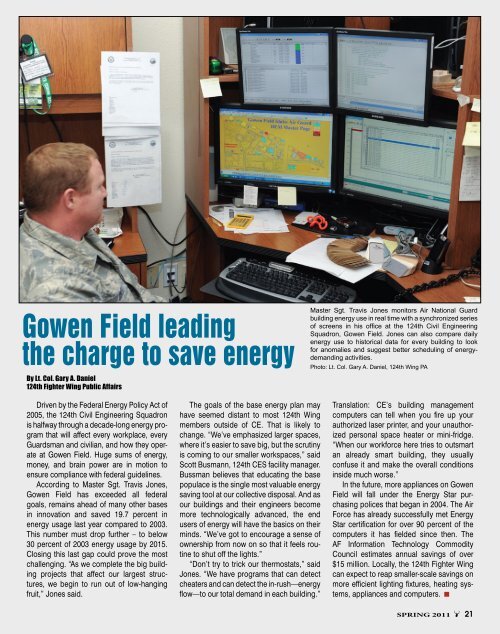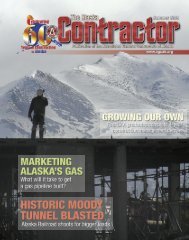The Gem State Guardian - Spring 2011 - Keep Trees
The Gem State Guardian - Spring 2011 - Keep Trees
The Gem State Guardian - Spring 2011 - Keep Trees
Create successful ePaper yourself
Turn your PDF publications into a flip-book with our unique Google optimized e-Paper software.
Gowen Field leading<br />
the charge to save energy<br />
By Lt. Col. Gary A. Daniel<br />
124th Fighter Wing Public Affairs<br />
Driven by the Federal Energy Policy Act of<br />
2005, the 124th Civil Engineering Squadron<br />
is halfway through a decade-long energy program<br />
that will affect every workplace, every<br />
Guardsman and civilian, and how they operate<br />
at Gowen Field. Huge sums of energy,<br />
money, and brain power are in motion to<br />
ensure compliance with federal guidelines.<br />
According to Master Sgt. Travis Jones,<br />
Gowen Field has exceeded all federal<br />
goals, remains ahead of many other bases<br />
in innovation and saved 19.7 percent in<br />
energy usage last year compared to 2003.<br />
This number must drop further – to below<br />
30 percent of 2003 energy usage by 2015.<br />
Closing this last gap could prove the most<br />
challenging. “As we complete the big building<br />
projects that affect our largest structures,<br />
we begin to run out of low-hanging<br />
fruit,” Jones said.<br />
<strong>The</strong> goals of the base energy plan may<br />
have seemed distant to most 124th Wing<br />
members outside of CE. That is likely to<br />
change. “We’ve emphasized larger spaces,<br />
where it’s easier to save big, but the scrutiny<br />
is coming to our smaller workspaces,” said<br />
Scott Busmann, 124th CES facility manager.<br />
Bussman believes that educating the base<br />
populace is the single most valuable energy<br />
saving tool at our collective disposal. And as<br />
our buildings and their engineers become<br />
more technologically advanced, the end<br />
users of energy will have the basics on their<br />
minds. “We’ve got to encourage a sense of<br />
ownership from now on so that it feels routine<br />
to shut off the lights.”<br />
“Don’t try to trick our thermostats,” said<br />
Jones. “We have programs that can detect<br />
cheaters and can detect the in-rush—energy<br />
flow—to our total demand in each building.”<br />
Master Sgt. Travis Jones monitors Air National Guard<br />
building energy use in real time with a synchronized series<br />
of screens in his office at the 124th Civil Engineering<br />
Squadron, Gowen Field. Jones can also compare daily<br />
energy use to historical data for every building to look<br />
for anomalies and suggest better scheduling of energydemanding<br />
activities.<br />
Photo: Lt. Col. Gary A. Daniel, 124th Wing PA<br />
Translation: CE’s building management<br />
computers can tell when you fire up your<br />
authorized laser printer, and your unauthorized<br />
personal space heater or mini-fridge.<br />
“When our workforce here tries to outsmart<br />
an already smart building, they usually<br />
confuse it and make the overall conditions<br />
inside much worse.”<br />
In the future, more appliances on Gowen<br />
Field will fall under the Energy Star purchasing<br />
polices that began in 2004. <strong>The</strong> Air<br />
Force has already successfully met Energy<br />
Star certification for over 90 percent of the<br />
computers it has fielded since then. <strong>The</strong><br />
AF Information Technology Commodity<br />
Council estimates annual savings of over<br />
$15 million. Locally, the 124th Fighter Wing<br />
can expect to reap smaller-scale savings on<br />
more efficient lighting fixtures, heating systems,<br />
appliances and computers.<br />
SPrinG <strong>2011</strong> 21

















